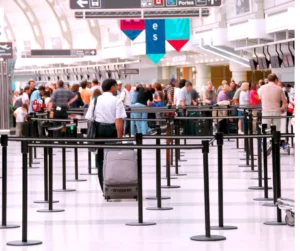Traveling with Hearing Aids: A Checklist

Traveling with hearing aids opens a world of new experiences mingled with unique challenges. Imagine you’re in the midst of a thrilling adventure when suddenly your hearing aid batteries give out. Or perhaps you’re facing the daunting task of navigating communication barriers in a foreign language. This guide transforms your hearing aids from a mere accessory to a reliable travel companion, ensuring you’re well-prepared for every aspect of your journey. Let’s dive into the essentials of traveling with hearing aids and transform potential travel woes into wows.
Explore more about the benefits of Bluetooth hearing aids for travel.
Understanding Your Rights While Traveling with Hearing Aids
Your journey begins with a clear understanding of your rights.
Familiarize yourself with the Air Carrier Access Act and ADA guidelines catering to hearing loss travelers. These include accessible reservation services and effective communication during flights. When booking your flight, don’t hesitate to request special accommodations like disability seating and preboarding.
Proactively communicate your hearing loss needs with airline staff to facilitate clear interactions.
Essential Supplies for Your Hearing Aids
A well-packed kit can keep your hearing aids in top shape throughout your travels.
- Pack extra batteries and a fully charged battery charger to anticipate potential delays and climate changes.
- Include a portable drying kit to combat humidity and a cleaning kit for regular maintenance.
- Don’t forget to pack spare earmolds or domes, and if your hearing aids are rechargeable, remember the charging station.
- Keep your hearing aids in a secure and easily accessible location in your carry-on.
- Opt for a labeled, protective travel case to keep your hearing aids and accessories organized and safe.
Documentation and Digital Tools for Enhanced Communication
Equip yourself with essential documentation and tools to ease your travel experience.
- Notify the airline about your hearing aids during booking, and keep a doctor’s note or audiogram at hand.
- Leverage technology by downloading apps for live transcription, language translation, and noise cancellation.
- Investigate accessibility options at your destination and inform your travel companions about your hearing loss.
- Develop communication strategies, like nonverbal cues, with your travel companions for smoother interactions.
- Always be prepared to seek assistance when needed and carry a notebook for alternative communication.
- Consider investing in travel insurance that includes hearing aid loss or damage coverage.
Maximizing Your Travel Experience with Hearing Aids
To fully enjoy your travels, more than just the essentials are needed.
- Embrace new experiences with confidence, knowing your hearing aids are well-prepared for any situation.
- Engage with local cultures and environments, making your hearing aids integral to the discovery process.
- Stay open to the unexpected, allowing your hearing aids to enhance rather than hinder your adventures.
Preparing for a trip with hearing aids is an art that involves thoughtful planning and organization. By arming yourself with the right information, supplies, and mindset, you can embrace the joys of travel with ease and comfort. Your hearing aids are not just tools but gateways to exploring the wonders of the world. Let this guide be your roadmap to a journey filled with enriching experiences and unforgettable memories.
Find out about the advantages of the best Bluetooth hearing aids.

Hearing Aids and Flying: Navigating Airport Security and In-Flight Comfort
Traveling with hearing aids involves more than just packing your bags; it requires a strategic approach to navigate airport security and manage your devices during flights. This comprehensive guide is designed to help you through every step of the process, ensuring a smooth and stress-free travel experience.
Airport Security Procedures for Hearing Aid Users:
Understanding the protocols at airport security checks can significantly ease your journey.
- During Security Checks: Keep your hearing aids on during metal detector or body scanner checks. They are designed to be security-friendly.
- Communicating with Security Staff: Proactively inform the security officer about your hearing aids. This heads off any confusion and may involve additional screening, such as a pat-down or hand-held scanning.
- Details about Your Hearing Aids: Be prepared to provide information about your hearing aids, including their type, manufacturer, and if they contain any metal components.
- Identification as a Hearing-Impaired Traveler: Wearing a “hearing impaired” card or tag can expedite the screening process by making the security staff aware of your condition.
Preparing for Security Screening
Efficient preparation can make your security check experience seamless.
- Accessible Storage: Store your hearing aids in an easily accessible spot within your carry-on luggage in case they need to be shown to security personnel.
- Carry Essential Documentation: Make any relevant documentation, like a doctor’s note or audiogram, available to provide additional context about your hearing aids.
- Stay Informed: Regularly check the TSA website or app for the latest guidelines on traveling with hearing aids.
Handling Hearing Aids at Airport Security
Proper handling of your hearing aids during security checks is crucial.
- Maintain Wear: Keep your hearing aids in place when passing through security, but inform TSA personnel about them.
- Prevent Damage: Avoid placing your hearing aids on the conveyor belt or in plastic bins to prevent static electricity and potential damage. If necessary, ask for assistance.
Utilizing Airport Hearing Loops
Many airports are equipped with induction loop systems, which are beneficial for hearing aid users.
- Telecoil Setting: These systems transmit signals directly to hearing aids set to the “telecoil” or “T” setting, improving audio clarity amidst airport noise.
- Checking Compatibility: Ensure your hearing aids are compatible with telecoil systems and switch to the appropriate setting when in the airport.
- Consult Your Provider: If you’re unsure about your hearing aids’ compatibility, consult with your hearing healthcare provider before traveling.
Managing Hearing Aids During Flights
Ensuring comfort and clear communication during flights is essential for a pleasant journey.
- Wearing Your Hearing Aids: Unlike other electronics, hearing aids need not be turned off during any stage of the flight. They can be instrumental in hearing announcements and conversing with companions or flight staff.
- Use with In-Flight Entertainment: Hearing aids can safely be used with in-flight entertainment systems, though it’s important to note that not all content may be captioned.
- Taking Breaks: Allow your ears to rest periodically during long flights by taking breaks from wearing your hearing aids.
Enhancing Communication
Additional strategies can help you navigate the noisy environment of a plane.
- Use Visual Cues: Pay attention to visual cues to supplement your hearing, especially when background noise is high.
- Flight Crew Communication: Inform a flight attendant about your hearing loss to ensure you don’t miss important announcements or instructions.
By adhering to these guidelines and being proactive, you can navigate airport security effortlessly and manage your hearing aids effectively during flights. Preparation and knowledge are key to enjoying your travel journey with hearing aids, turning potential challenges into comfortable experiences.
Learn more about hearing aid repairs that you can handle.
Enhancing Travel Experiences for Individuals with Hearing Loss: Apps and Gadgets Guide
Traveling with hearing loss can be a complex but manageable adventure, especially with the aid of technology. This guide explores a variety of apps and gadgets specifically designed to overcome the challenges faced by travelers with hearing impairments, transforming each trip into a more accessible and enjoyable experience.
Essential Travel Apps for Hearing Impairments
The digital age brings a suite of apps to assist those with hearing loss in communication and navigation.
- Live Transcription Apps: Tools like Google Live Transcribe and Ava are invaluable for the real-time conversion of spoken words into text, making it easier to follow conversations and announcements in noisy environments.
- Noise Measurement Apps: Apps such as Decibel X and Sound Meter are practical for monitoring ambient noise levels, helping you to steer clear of potentially harmful loud environments.
- Language Translation Apps: For those journeying internationally, apps like Google Translate and Microsoft Translator provide essential real-time translation of both spoken and written languages, breaking down language barriers.
- Travel-Specific Accessibility Apps: Resources like The Rebel Traveler’s Guide to the World and HearHere offer specific information on accessibility, including locations with hearing loop systems, enhancing your travel experience.
Gadgets to Improve Travel for Hearing Aid Users
Beyond apps, certain gadgets can significantly enhance the travel experience for those with hearing aids.
- Personal Sound Amplifiers (PSAPs): These devices boost ambient sounds, ensuring clearer speech comprehension in bustling environments such as airports or tourist attractions.
- Neck Loops: These gadgets are a boon for transmitting audio signals directly from various sources, such as smartphones or information kiosks, to your hearing aids.
- Portable Drying Kits: Particularly vital in humid climates, these kits efficiently remove moisture from hearing aids, maintaining their functionality.
- Noise-Canceling Headphones: These headphones are perfect for creating a quieter listening environment, especially useful during flights or in busy public spaces.
- Customizable Hearing Aid Accessories: Accessories like ear hooks, custom earmolds, and remote controls allow for a more personalized and comfortable hearing aid experience, catering to different ear shapes and user preferences.
Additional Considerations for Technology-Assisted Travel
- Stay Updated: Keep your apps and gadgets updated to ensure you have access to the latest features and improvements.
- Battery Backup: Always carry extra batteries or charging solutions for your devices to avoid any interruptions in their functionality.
- Practice Makes Perfect: Familiarize yourself with these tools before your trip, ensuring comfort and ease of use when you’re on the go.
By embracing these innovative apps and gadgets, individuals with hearing loss can navigate their travels with greater confidence and ease. This technological support not only enhances communication and accessibility but also ensures a more relaxed and enjoyable travel experience. With the right tools in hand, every journey becomes an opportunity for adventure and discovery.

Traveling with Hearing Aids Confidently
As you gear up for your next travel adventure, we highly recommend a visit to your local Stanford Hearing center. Our experienced audiologists are on hand to provide you with tailored advice, ensuring your hearing aids are perfectly prepped for your trip. With these steps, you’re not just prepared; you’re empowered to explore the wonders of the world confidently. Your hearing aids are more than just devices; they’re your passport to new experiences and adventures.
